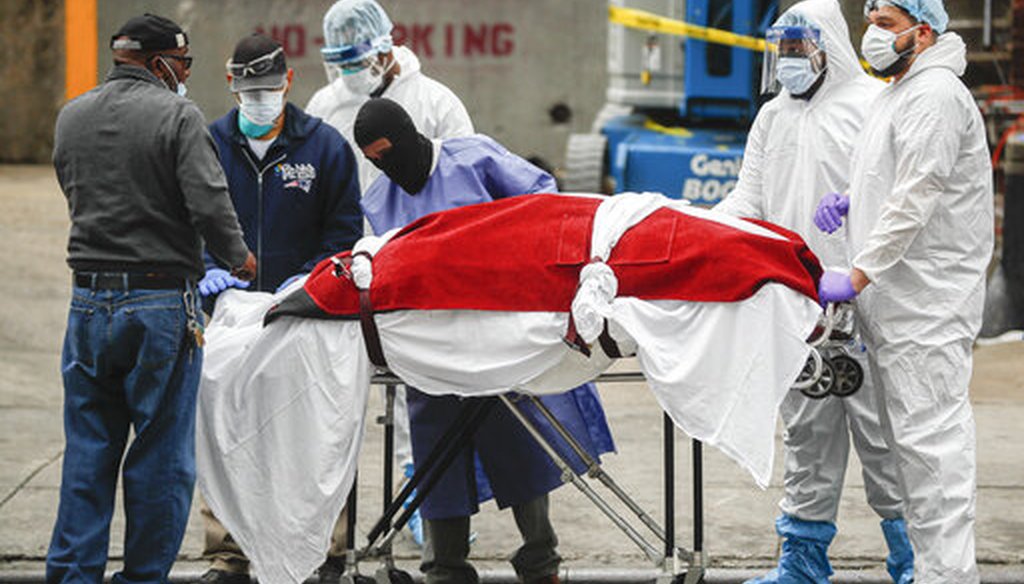Stand up for the facts!
Our only agenda is to publish the truth so you can be an informed participant in democracy.
We need your help.
I would like to contribute

A body wrapped in plastic that was unloaded from a refrigerated truck is handled by medical workers wearing personal protective equipment on March 31, 2020, at Brooklyn Hospital Center in New York City. (AP)
If Your Time is short
• If 240,000 Americans die of coronavirus, as the White House offered as a high-end projection, then the virus would leap to the third biggest killer of Americans, based on past trends.
• If 100,000 die from the virus, which the White House set as the low end projection, it would rank as the seventh-biggest killer.
• However, coronavirus numbers can be more volatile than for most of the other leading causes of death, because it is an infection that can spread exponentially. Most of the other causes of death have settled into a fairly predictable number of casualties per year.
How does the potential scale of mortality in the United States from coronavirus compare with the leading causes of death in a typical year? It’s not an easy question to answer.
We put together the following chart to try to offer some context to the lower and upper projections of coronavirus deaths offered by the White House in late March. The White House said that with social distancing rules in place, the number of coronavirus deaths could range from 100,000 to 240,000.
Some experts have questioned the methodology that produced that range, and the White House did not specify what time frame would produce that number of deaths. But we’ll use the range here because they are the most solid numbers the government has communicated to the public.
The chart below compares the higher and lower White House estimate to the numbers for the 15 leading causes of death in 2017, the most recent year for which data has been calculated by the Centers for Disease Control and Prevention. (Obviously, as more is known about the course of the coronavirus pandemic, the actual number of deaths could be higher or lower.)
In 2017, two causes of death significantly exceeded the upper estimate of 240,000 for coronavirus deaths: Heart disease killed 647,457 Americans, while cancer killed 599,108.
Four other categories exceed the lower level of 100,000 coronavirus deaths: Accidents at 169,936; bronchitis, emphysema, and asthma at 160,201; stroke at 146,383; and Alzheimer’s disease at 121,404.
In other words, if the number of coronavirus deaths reaches the higher federal estimate, and other trends stay in place, it would immediately rank as the third-highest killer of Americans in 2020. If the number of deaths hits the lower estimate, it would rank as the seventh-leading cause of death.
The lower estimate of coronavirus deaths would still exceed the following causes of death by substantial margins: diabetes at 83,564, influenza and pneumonia at 55,672, kidney disease at 50,633, suicide at 47,173, liver disease and cirrhosis at 41,743, bloodstream infections at 40,922, hypertension at 35,316, Parkinson disease at 31,963, and non-infectious lung inflammations at 20,108. (All other causes of death combined to 561,920 deaths in 2017.)
Experts urged caution in comparing these causes of death.
First, it’s important to remember that most of the causes of death on our list are not primarily driven by infections. So they don’t present the risk of exponential growth rates that coronavirus does. If mitigation measures aren’t effective, coronavirus deaths could spike far higher than anything else on the list.
The coronavirus "is a very large-scale public health event," said David Rosenbloom, a professor at the Boston University School of Public Health. "We have no human immunity to a virus that spreads very quickly and causes death for a subset of vulnerable people."
The only two categories on the list of leading killers that are infectious are influenza and bloodstream infections, which in 2017 combined for about 97,000 deaths. So even at the low end of the projections, the United States is looking at a doubling of such deaths this year.
Second, coronavirus is testing the capacity of the U.S. health care system. The other leading killers tend to be fairly predictable in cases from year to year, and the system had adapted itself to handle the typical levels. By contrast, coronavirus surged suddenly, forcing the health system to scramble to address the surge of patients.
Indeed, there will inevitably be an interplay between the spread of coronavirus and the other leading causes of death. Some of the people who would have died of other causes in 2020 will end up dying from coronavirus, pushing down the number of deaths in other categories. This is especially true because coronavirus is more likely to become fatal if the patient has underlying medical conditions.
By the same token, the surge of coronavirus cases could end up increasing deaths by other causes, because coronavirus patients will take up hospital beds and practitioners’ time that might otherwise be given to patients with other illnesses. At this point, we don’t know whether the net impact will produce higher or lower numbers of other deaths in 2020, but there is almost certain to be some impact.
Third, the leading causes of death all have different risk factors, which can make it hard for people to understand how concerned they should be about their own health.
"Some are higher or lower depending on behavioral and lifestyle factors, such as heart disease, emphysema, accidents, and diabetes, while some are higher or lower based on age, such as cancer, Alzheimer’s, Parkinson’s and stroke," said David Ropeik, a consultant, retired Harvard University instructor and author of the book "How Risky Is it, Really? Why Our Fears Don’t Always Match the Facts."
Some causes of death, Ropeik said, are higher or lower based on "our general physical or psychological health status, such as influenza and suicide. And all of these generalizations are for the total U.S. population, within which risk varies wildly by age, gender, race, socioeconomic status, and other factors. So the numbers are only the crudest way of putting things in perspective."
Finally, and perhaps most importantly, the rapid growth of the pandemic, combined with its infectious nature, has left the scale of the casualties unusually dependent on the public policies implemented.
"We are at this uncontrolled pandemic stage in the U.S. because our political leadership failed to recognize the warnings they were given and because we have systematically weakened our public health response infrastructure," Boston University’s Rosenbloom said. "The death rate will be higher than it should have been because of these failures."
When we asked Arthur L. Caplan, the founding head of the division of medical ethics at the New York University School of Medicine, how he tries to understand the impact of the coronavirus pandemic, he talked less about the scale of deaths and more about how its spread is forcing Americans to become familiar with social norms and grim practices they largely haven’t encountered before.
For instance, Caplan pointed to how African nations experienced Ebola virus outbreaks over the past decade and had to undergo some of the same changes that Americans are now adapting to.
He said Ebola outbreaks drove changes in how funerals had to be handled, and they lowered expectations about how much access family members had to patients who are seriously ill.
He added that the shortage of ventilators is forcing hospitals to decide which patients get scarce resources. This reminds Caplan of the longstanding experience of patients seeking organ transplants.
"If you ask transplant patients, they are used to rationing," Caplan said. "But it’s not something most people think about. Now, with coronavirus, rationing looms as a source of great panic for all of us."
Our Sources
Centers for Disease Control and Prevention, "Deaths: Final Data for 2017," June 24, 2019
Washington Post, "Experts and Trump’s advisers doubt White House’s 240,000 coronavirus deaths estimate," April 2, 2020
Centers for Disease Control and Prevention, "Drug Overdose Deaths," accessed April 3, 2020
Email interview with David Rosenbloom, professor at the Boston University School of Public Health, April 2, 2020
Email interview with David Ropeik, consultant, retired Harvard University instructor and author of the book "How Risky Is it, Really? Why Our Fears Don’t Always Match the Facts," April 2, 2020
Interview with Arthur L. Caplan, founding head of the division of medical ethics at the New York University School of Medicine, April 2, 2020








































